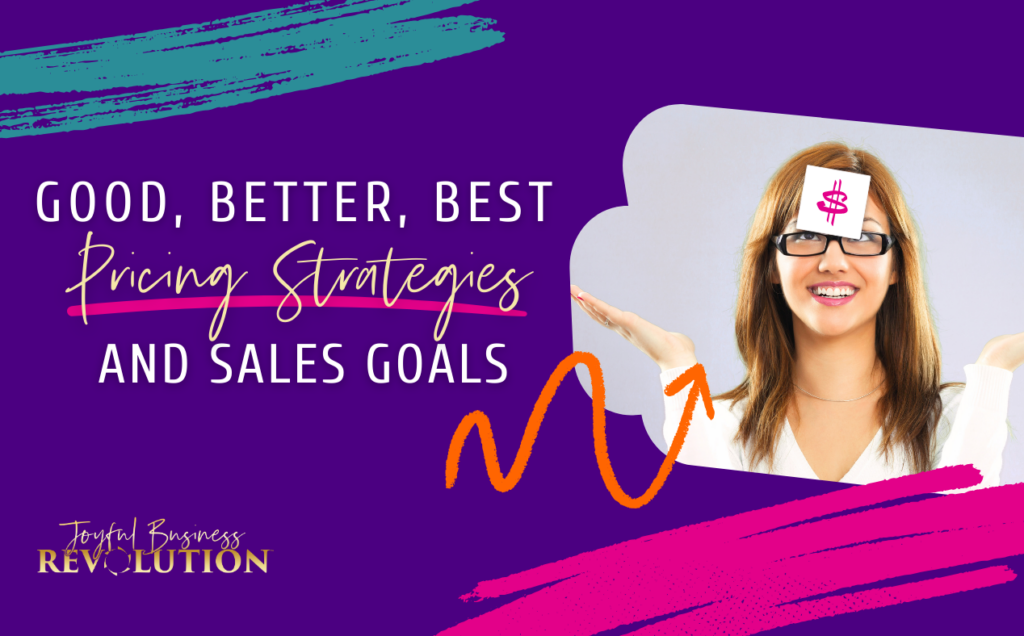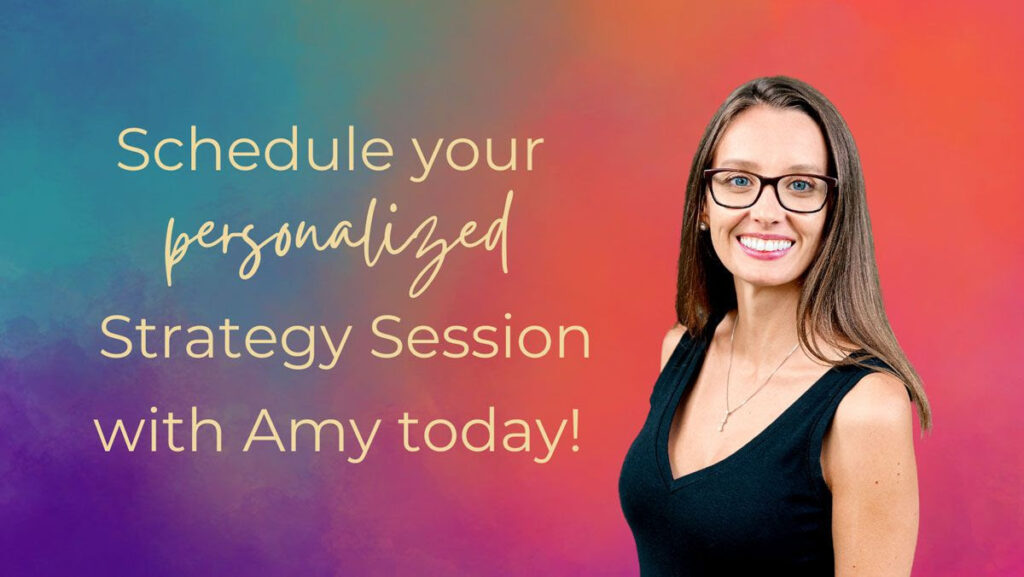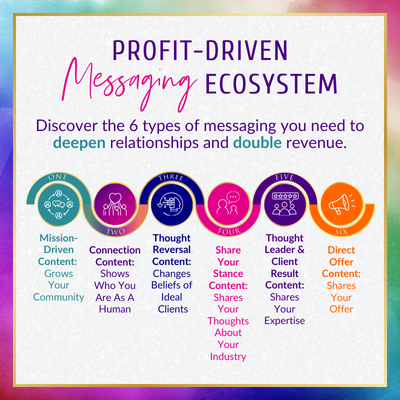When I hear the phrase good-better-best pricing, coaching services don’t come to mind.
Neither does the kind of business we’re building at Joyful Business Revolution™. In fact, the very idea of good-better-best pricing triggers a visceral reaction. I’d never describe anything we offer as anything less than 100%.
Sure, you could make the case for good-better-best or usage-based pricing with cable or internet providers, because, let’s face it — not all things are created equal.
But you’re not a cable plan or streaming service.
When it comes to services—especially transformational, human-centered services—diluting your work to a “good” or “better” option devalues what you do.
So, we don’t use—or teach—good-better-best pricing around here. We do, however, focus on tiered pricing strategies grounded in profitable pricing and designed to meet your audience where they are.
From there, we set good-better-best sales goals—because that’s where this framework actually works.
By shifting away from traditional goal-setting (and the goal trauma that often comes with it), you can create realistic sales targets that support your business and your energy.
The whole idea came from my classroom days—where a less-than-perfect grade often made students feel like failures. Yet, when they had the opportunity to improve, I watched these kids light up.
And that’s exactly what this approach does in business.
Because when you combine profitable offers, tiered pricing, and good-better-best sales goals you have a business that— yes, is profitable— also gives you the space you need to grow on your terms.
This is how we do it.
What Is the Good-Better-Best Pricing Model (and What Is It NOT)?
The good-better-best pricing model is rooted in consumer psychology. It anchors your price with the good and then gently upsells to a higher tier.
Want the basics? Choose the “Good” plan.
Need a few more features? That’s the “Better” tier.
All-in, full access, no limits? You’re in “Best.”
People typically gravitate towards the middle option —after all, it feels like a safe bet—Goldilocks style. Not too big or luxurious, not too small, but juuuust right.
So why doesn’t it work for coaching or consulting services?
When it comes to coaching, consulting, messaging—or any kind of relational, strategic work—you can’t just stack features and call it a day.
Instead, I believe every offer you put into the world should be 100% valuable.
Not 60%. Not “good enough.” And definitely not “basic.”
Your brilliance can’t be distilled to basic—and there is no good, better, or best version of your genius.
So it’s time to stop presenting your services that way.
Wondering what tiered pricing looks like in our world? It’s all based on levels of access to our team:
- A DIY library of on-demand courses to help people with tighter budgets troubleshoot and problem-solve
- A group mastermind option that offers community, support, and momentum
- A high-touch 1:1 business growth program for deep, customized support
The second and third tiers, incidentally, are part of the same program — just with different levels of access based on different budgets and price points.
Note: We also offer a suite of a la carte 1:1 services for specific outcomes.
I want to be very clear — when we use tiered pricing, we do not reduce the value people get from us. Instead, we’re scaling the access to us and the time it takes us to deliver services.
Because it’s not that someone isn’t ready to invest with us. It’s often that their business might not be ready to support that investment.
And that’s perfectly okay — and normal. So we’re focused on meeting people where they are without shame or pressure to help them build momentum, confidence, and results.
Why We Pair Good-Better-Best Sales Goals With Pricing Models
You’ve probably been told to “set a big revenue goal and go for it.”
But what happens when you miss it?
Maybe you keep on trucking and sleep just fine.
But for me? It can be paralyzing, and I beat myself up for not meeting my goals. From there it’s a downward spiral.
That’s the thing about goal trauma. When you internalize it, it doesn’t just mess with your motivation.
It messes with your sense of self. That voice in your head starts to twist the story:
Maybe I’m not cut out for this. Maybe I’m not good enough. Maybe I should quit.
We all deserve better. That’s why we don’t set one big number and hope for the best.
Instead, we use good-better-best sales goals that are built around how your business actually functions.
It’s rooted in the same philosophy I used in the classroom. I mentioned it above, but here’s how it worked:
When I was teaching in Spanish Harlem, I didn’t hand out Cs, Ds, or Fs—at least not when I had a principal who supported what I was doing.
I used three grades:
- A – You nailed it.
- B – You’re almost there.
- Not Yet – You’re not there… yet. But here’s how to get there.
Students with B’s and Not Yets almost always came back, reworked their assignments, and improved their grades.
But in years when I had to give out traditional grades, even when I offered the same opportunity to revise, hardly anyone took me up on it.
Why?
Because when you’re told you failed, you start to believe it’s who you are. But when you’re told you’re not there yet—you believe there’s a path forward.
That’s exactly what good-better-best sales goals create inside your business.
Pricing and Sales Goals Must Work Together
We use this model across all our offers—whether it’s a launch, an ongoing program, or a live event.
Here’s what it looks like in practice:
- Good = What we need to stay profitable and maintain our delivery quality
- Better = What helps us grow, reinvest, or bring on more support
- Best = A stretch goal we’d celebrate if everything aligns, but doesn’t break us if we don’t get there
These goals are tied directly to our profitable service offerings, with pricing based on our Profitable Pricing Calculator.
Because you can’t identify a meaningful sales goal if you don’t know whether or not your pricing is profitable.
To be very clear, when I talk about profitability, I don’t just mean “it covers your time.” When your offer is profitable, it means your pricing accounts for:
- Your delivery time and prep
- Your team (if you have one)
- Tools and platforms
- Your energy and capacity
- Your actual life (vacations, caregiving, sick days, etc.)
This is what we call joyful pricing—pricing that lets your business support you while you support others.
When your offers are priced for profit, even your “Good” sales goal gets you where you need to be.
That means every sale feels like a win.
Every tier is sustainable.
Most importantly of all, every goal becomes a milestone to celebrate—not a measurement of your worth.
Real Examples of Tiered Pricing for Coaching and Consulting
Tiered pricing and good-better-best sales goals sound fantastic to a lot of people I talk with. But when it comes to figuring out how it actually works for their businesses, they’re often overwhelmed.
So let’s take this from concept to practice.
We use profitable pricing strategies and feel-good sales goals in every part of our business.
In fact, everything we do is structured around clear, intentional, service offerings that are profitable, ethical, and flexible.
We are committed to giving people access to quality coaching for marketing and messaging—without pushing them into high-ticket decisions they’re not ready for.
Because here’s the truth:
- Not everyone needs private coaching right now.
- Not every business is ready for a $10K+ investment.
- And we are not here to make people feel less than because they can’t commit at the top tier.
Instead, we’ve structured our offers to meet people where they are—without judgment.
Here’s how our tiered pricing strategy plays out:
Our core programs serve people at different price points, based on:
- The time and energy it takes to deliver
- The support required before, during, and after
- Our team’s capacity (including mine)
- And most importantly, the level of access each client needs
And because each service is priced for profit, we can layer in Good-Better-Best sales goals to help us reach our income targets.
| Offer | Good Goal | Better Goal | Best Goal |
| Joy Fueled™ 1:1 Coaching | 1 client/season | 2 clients/season | 3 clients/season |
| JFB Mastermind | 4 clients/season | 5 clients/season | 6 clients/season |
| Email Marketing Makeovers | 3/month | 4/month | 5/month |
| Sales Page Audits | 2/month | 6/month | 10/month |
| Uncorked in Italy | 2 seats/month | 3 seats/month | 3seats/month |
Capacity plays a huge role for us. For our Joy Fueled™ program, we can onboard 1-2 people per month at most, so we pace our goals for that.
Instead of trying to max out every tier, we fill in around that with other offers to create a business that makes money and feels sustainable.
This is where pricing strategy meets sales forecasting—and where your business model starts working for you, instead of constantly demanding more from you.
Because when every service is priced for profit, even your “good” goal supports your business.
And when every tier offers real value, you don’t have to worry about which offer someone chooses. They’re all wins.
Did any of these offers jump out at you?
If you’d like to talk through which is the right fit, please schedule a 20-minute call with Amy. She’ll walk you through the different options and help you find your best next steps.
When Good-Better-Best Isn’t the Right Fit
Tiered pricing and good-better-best sales goals are not one-size-fits-all. They shouldn’t be. Here are a few things to remember:
- What’s profitable for my business might not be for yours—and vice versa.
- Not every offer needs three access points.
- Not every business is in a place where it makes sense to scale delivery. We didn’t have a DIY course library until our 12th year in business.
What’s more, while our business is focused on graduating people from our programs once they’ve reached the next level, not everyone’s business is designed that way. And that’s okay.
So when we work with business owners on joyful or profitable pricing, we don’t try to impose a one-size-fits-all pricing strategy.
Instead, we always start with one question: What does your business need to feel sustainable and regenerative—for you and the people you serve?
For us, a regenerative business model means we can support more people without compromising our energy, ethics, or delivery quality.
Investment Trauma Is Real
There’s a woman I met in a local networking group. We’d had lunches together for months, and one day, she pulled me aside and said: “I need to talk to you.”
So I set her up with Amy for a strategy call.
Over the course of our conversations with her, we learned that she had taken out a $100,000 loan to invest in her business to cover a $50K mastermind, a $10K website, and other “must-have” marketing expenses.
Three years later, she still hadn’t signed a single client. And understandably, she was overwhelmed and disheartened.
That is what investment trauma looks like.
It’s what happens when someone is sold an offer that their business simply isn’t ready for.
We will never tell you to take out a loan to pay for our services. If anyone does, that’s a giant red flag to run, not walk away.
Instead of shelling out more money, this woman’s best next step was to find and sign perfect-fit clients and pay off the loan. And we told her exactly that.
Remember: Business Growth Has Cycles
This applies to your clients—and to you.
I said it above, but it bears repeating here: sometimes your client is ready, but their business isn’t.
That doesn’t mean they’re not capable and it definitely doesn’t mean they aren’t worthy.
They need the right offer for the stage they’re in right now—and the confidence that they can build toward what comes next.
Tiered pricing helps with that. But so does your mindset as a service provider, coach—or whatever you call yourself.
When you offer ways for people to enter your world at a level that feels safe, supportive, and aligned—you give them the opportunity to say yes without shame.
In addition to making space for real growth, I want to normalize the thinking that every business has seasons.
How to Create Your Own Good-Better-Best Sales Goals and Tiered Pricing Strategy
If you’ve ever picked a number out of thin air and ran with it on a hope and a prayer that it would be profitable, this is for you.
At Joyful Business Revolution, we start with what’s real, what’s grounded, and what’s sustainable—for you.
And it all begins with profitable pricing.
Step 1: Start with Profit-First Pricing
Before you can set meaningful sales goals, you need to know your pricing works for your business. No more shots in the dark, please-and-thank-you.
That’s why we created the Priced for Profit Calculator.
It helps you determine the true cost of delivering each of your services—including time, tools, energy, prep, support, and your actual life—and then helps you reverse-engineer a price that supports your capacity, your team, and your goals.
Because if you’re undercharging, even the biggest sales goal won’t get you where you want to go.
We recommend using the calculator on:
- 1:1 services
- Group programs
- Workshops, events, and intensives
That’s how you make sure every offer—at every tier—supports your business.
Interested in the calculator?
We’ve paired it with the Reclaim Your Revenue Mini Intensive to help you make sense of the results. You can get the details here.
Step 2: Layer in Tiered Pricing Options (If It Makes Sense)
Once you’ve priced your services for profit, you can explore tiered access pricing strategies.
You’ve seen examples of this above.
- A single service with three levels of access
- A foundational offer plus upgrades or bundles
- A mix of DIY, group, and 1:1 pathways
This isn’t about assigning value to people or transformation. It’s about meeting different customer segments where they are—without shame or pressure.
Reminder: Not every offer needs tiers.
This is about building the right pricing model for your brand, your business, and your energy.
Step 3: Apply Good-Better-Best Sales Goals
Once your offers are priced for profit, it’s time to map out realistic sales goals.
Here’s a quick recap of how we define them:
- Good = Keeps you profitable and protects your time
- Better = Helps you grow or reinvest
- Best = A stretch you’d celebrate—but not stress over
You can do this by offer, by month, by launch, or by season—whatever works with your energy and delivery model.
When your goals reflect your reality and your capacity, you’re no longer chasing numbers for the sake of it.
Step 4: Track and Adjust Season by Season
Every business has seasons. Some are for building. Some are for resting. Some are for big growth.
Every business should also pay attention to its numbers. It’s easy to sweep it under the rug, but look at everything from email open rates, conversions, # of sales calls, and actual sales.
Then check in with your pricing and sales goals quarterly to see if
- Your offers are still profitable.
- Your pricing aligns with capacity and value.
- Your goals feel exciting—or exhausting.
Then adjust. It’s your business and you get to decide what works for you.
You Deserve a Business That Feels Good to Run
If you take anything away from this post, it should be these three things:
- Pricing doesn’t have to feel like a guessing game.
- Sales goals don’t have to feel like punishment.
- And your business should support your life—not the other way around.
When you build your offers around profitable pricing, and set good-better-best sales goals rooted in your reality, you create so much more than revenue.
The momentum, sustainability, and joy make your business—and your mission—into something that enhances your life.




